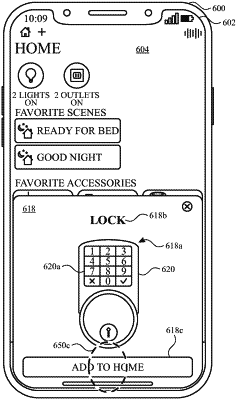| CPC G07C 9/00309 (2013.01) [G06F 3/04842 (2013.01); G06F 3/04847 (2013.01)] | 36 Claims |

|
1. A computer system configured to communicate with a display generation component and one or more input devices, comprising:
one or more processors; and
memory storing one or more programs configured to be executed by the one or more processors, the one or more programs including instructions for:
displaying, via the display generation component, an account user interface that includes a user account lock object;
while displaying the user account lock object, receiving, via the one or more input devices, a first input corresponding to selection of the user account lock object;
in response to receiving the first input, displaying, via the display generation component, a user account lock user interface corresponding to a first account, wherein the user account lock user interface includes concurrent display of:
a first electronic lock object corresponding to a first electronic lock that is separate from the computer system;
a first status object that indicates whether the first electronic lock is configured to unlock using credentials of the first account;
a second electronic lock object corresponding to a second electronic lock that is separate from the computer system; and
a second status object that indicates whether the second electronic lock is configured to unlock using credentials of the first account; and
while displaying the user account lock user interface corresponding to the first account:
receiving second input; and
in response to receiving the second input:
in accordance with a determination that the second input corresponds to selection of the first status object corresponding to the first electronic lock, changing whether the first electronic lock is configured to unlock using credentials of the first account; and
in accordance with a determination that the second input corresponds to selection of the second status object corresponding to the second electronic lock, changing whether the second electronic lock is configured to unlock using credentials of the first account.
|